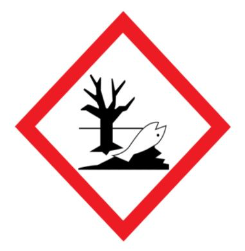FREE WHMIS Hazard Classes and Symbols Questions and Answers
What does the following border signify?

Explanation:
The border signifies "Container Itself Can Be Dangerous" in the WHMIS context. This symbol is used to indicate that the container, particularly pressurized gas cylinders, poses a hazard due to the pressure within the container, regardless of the nature of the contents.
What does the following WHMIS symbol warn you about?

Explanation:
The Explosion Hazard symbol is a critical part of the WHMIS system, helping to alert workers to the presence of potentially explosive materials and the need for stringent safety precautions.
The following WHMIS symbol represents what type of material?

Explanation:
The WHMIS Flammable symbol indicates that the substance or mixture can easily ignite and burn. This symbol alerts workers to the presence of materials that pose a fire hazard.
Which of the following words don’t accompany a WHMIS symbol to indicate the severity of risk?

Explanation:
The WHMIS Warning symbol signifies that the substance or mixture poses moderate hazards to health. These hazards can include irritation, specific organ toxicity, and other harmful effects that are less severe than those indicated by more dangerous symbols.
What is the purpose of WHMIS?
Explanation:
The purpose of WHMIS (Workplace Hazardous Materials Information System) is comprehensive and includes all of the listed options. It is designed to identify hazardous materials within the workplace and ensure they are handled safely, reduce accidents and health hazards, and increase safety for everyone in the workplace. WHMIS achieves these goals through proper labeling, the provision of safety data sheets, and effective worker training. This system helps to create a safer work environment by informing workers about the risks associated with materials they may encounter and how to properly manage those risks.
What are the routes of entry for a chemical?
Explanation:
The routes of entry for a chemical into the body are inhalation, absorption, ingestion, and injection. Inhalation occurs when chemicals are breathed in through the nose or mouth. Absorption happens when chemicals penetrate through the skin or eyes. Ingestion is when chemicals are swallowed. Injection refers to chemicals entering directly into the bloodstream through a puncture in the skin. Understanding these routes helps in managing and preventing exposure to harmful chemicals.
What type of information does the WHMIS pictogram with a flame over a circle represent?
Explanation:
The WHMIS pictogram with a flame over a circle warns of oxidizing hazards. Oxidizers can dramatically increase the rate of fire by supplying oxygen, making them extremely dangerous in combustible environments. Recognizing this symbol helps prevent potential disasters by enforcing strict storage and handling guidelines that keep oxidizers away from flammable materials. This ensures a safer working environment, reducing the risk of fire outbreaks and promoting safe practices around substances that could otherwise exacerbate fire conditions.
Advertisement
Which WHMIS class includes flammable materials?
Explanation:
WHMIS Class B is designated for flammable materials, which include any substance that can ignite easily under normal conditions. This class is vital for workers to recognize as it encompasses flammable gases, liquids, and solids. Proper identification, handling, and storage of Class B substances are crucial in preventing fires and ensuring workplace safety. Workers trained to recognize and respect the properties of flammable materials contribute to a safer working environment, reducing the likelihood of fire-related incidents.
What does WHMIS stand for?
Explanation:
WHMIS stands for Workplace Hazardous Materials Information System. This system is designed to provide information about hazardous materials in the workplace, including their potential health effects, safe handling procedures, and necessary precautions. It is important for employees to be aware of and understand WHMIS in order to work safely with hazardous materials and protect their health.
What are the three types of hazards classified in WHMIS?
Explanation:
The correct answer is biological, chemical, and physical hazards. WHMIS (Workplace Hazardous Materials Information System) classifies hazards into three main categories: biological hazards, which include harmful microorganisms and biological toxins; chemical hazards, which include hazardous substances and mixtures; and physical hazards, which include flammable, explosive, and reactive materials. These classifications help ensure the safe handling, storage, and use of hazardous materials in the workplace.
The following WHMIS symbol means:

Explanation:
The WHMIS Dangerous to the Environment symbol indicates that the substance or mixture poses a risk to the environment. This symbol alerts workers to materials that can cause harm to ecosystems, wildlife, or the environment in general.